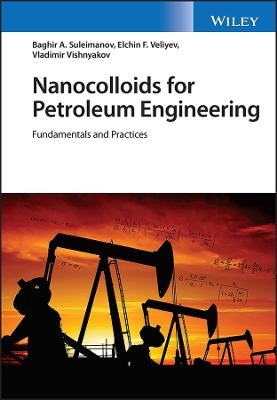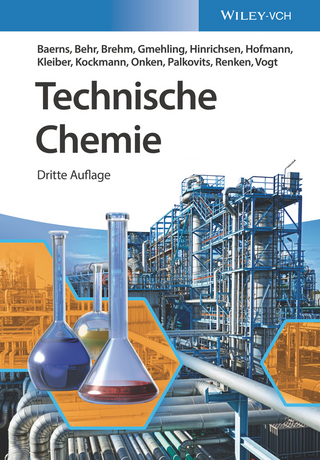
Nanocolloids for Petroleum Engineering
John Wiley & Sons Inc (Verlag)
978-1-119-88959-5 (ISBN)
Nanocolloids for Petroleum Engineering brings together the background, latest advances, and practical and theoretical information about nanocolloids for petroleum engineering in one comprehensive volume. The text is structured in such a way to allow readers to easily distinguish key points and quickly gain the expertise they need to become more effective in their respective disciplines. For practical purposes and to aid in seamless reader comprehension, experiences of service companies, general guidance, and problem solving exercises are included throughout the text.
The highly qualified authors specifically present the subject as petroleum experts and use a niche industry point of view, which means petroleum, reservoir, and drilling engineers will be able to quickly understand and digest the information contained within. Sample topics covered in the work include:
A brief introduction to and classification of colloid systems, describing the main properties of nanocolloids crucial for practical application in petroleum engineering
Nanocolloids application in reservoir engineering and development, illustrating reservoir conditions necessary for nanocolloids formation
Nanocolloid applications in production operations, including the mechanism of nanoscale dispersion phase impact on physical properties of conventional substances utilized in upstream processes
Nanocolloid application in Enhanced Oil Recovery (EOR) and the impact of nanoparticles on conventional displacement agents
Nanocolloids for Petroleum Engineering serves as a comprehensive reference work and standalone guide for petroleum engineers who are interested in gaining knowledge surrounding nanocolloids and harnessing that knowledge to aid in solving a wide variety of conventional challenges in the field.
Baghir A. Suleimanov is Deputy Director of the SOCAR "OilGasScientificResearchProject" Institute, Doctor of Technical Sciences and a Corresponding Member of Azerbaijan National Academy of Sciences. Elchin F. Veliyev is Deputy Manager of Laboratory of Analytical Research at the SOCAR "OilGasScientificResearchProject" Institute. Vladimir Vishnyakov is Director of Centre for Engineering Materials at the University of Huddersfield, PhD and a Fellow of Institute of Physics, UK.
Nanocolloids for Petroleum Engineering:
Theoretical and Practical Approach
Baghir Suleimanov, Elchin Veliyev, Vladimir Vishnyakov
INTRODUCTION
PART A. Nanocolloids – an overview
Chapter 1. Nanocolloids classification
1.1. What is colloid?
1.2. Colloids classification
1.3. Colloids evaluation
1.4. What is nanocolloid?
Chapter 2. Nanocolloids properties
2.1. Different kind of interactions in nanocolloids
Van der Waals interactions
Electrostatic interaction
Elastic-steric interaction
Hydrophobic interaction
Solvation interaction
Depletion interaction
Magnetic dipole-dipole interaction
Osmotic repulsion
2.2. The stability of nanocolloids
2.3. Rheology of nanocolloids
Effect of nanoparticles interaction on the colloids rheology
Effect of nanoparticles migration on the colloids rheology
2.4. Surface Tension.Wettability
Wettability alteration
Surface tension
References
PART B. Reservoir Development
Chapter 3. Reservoir conditions for nanocolloids formation
3.1. In-situ formation of nano-gas emulsions
Stability of the subcritical gas nuclei
3.2. In-situ formation of nanoaerosoles
Stability of the subcritical liquid nuclei
Chapter 4. Nano-gas emulsions in oil field development
4.1. Hydrodynamics of nano-gas emulsions
Flow mechanism of gasified Newtonian liquids
Annular capillary flow scheme
Slip effect
Concluding remarks
Flow of gasified Newtonian liquids in porous media at reservoir conditions
Fundamental equations
Apparent permeability
Steady-state flow
4.2. Hydrodynamics of nano-gas emulsions in heavy oil reservoirs
Flow mechanism of gasified non-Newtonian liquids
Annular capillary flow scheme
Slip effect
Flow of gasified non-Newtonian liquids in porous media at reservoir conditions
Capillary flow
Flow in a homogeneous porous medium
Flow in a heterogeneous porous medium
Concluding remarks
4.3. Filed validation of slippage phenomena
4.3.1. Steady state radial flow
Gasified Newtonian fluid flow
Gasified non-Newtonian fluid flow
4.3.2. Unsteady state flow
4.3.3. Viscosity anomaly near to phase transition point
Experimental procedures
Measurement of live oil viscosity
Phase behavior of live oil and viscosity anomaly
Surfactant impact on phase behavior of live oil and viscosity anomaly
Mechanism of viscosity anomaly
Mechanism of surfactant influence on phase behavior of live oil and viscosity anomaly
Concluding remarks
Chapter 5. Nanoaerosoles in gas condensate field development
5.1. Study of the gas condensate flow in porous medium
5.2. Mechanism of the gas condensate mixture flow
Rheology mechanism of the gas condensate mixture during steady-state flow
a) Annular flow scheme in a porous medium capillary
b) Slippage effect
Mechanism of porous medium wettability influence on the steady-state flow of the gas condensate
Mechanism of pressure build-up at the unsteady-state flow of the gas condensate
Concluding remarks
References
PART C. Production Operations
Chapter 6. An overview of nanocolloids application in production operations
Chapter 7. Nanosol for well completion
The influence of the specific surface area and distribution of particles on the cement stone strength
The influence of nano-SiO2 and nano-TIO2 on the cement stone strength
Regression equation
Concluding remarks
Chapter 8. Nano-gas emulsion for sand control
Fluidization by gasified fluids
Carbon dioxide gasified water as fluidizing agent
Natural gas or air gasified water as fluidizing agent
Chemical additives impact on fluidization process
Water-air mixtures with surfactant additives as fluidizing agent
Fluidization by polymer compositions
Mechanism of observed phenomena
Chapter 9. Vibrowave stimulation impact on nano-gas emulsion flow
Exact solution
Approximate solution
Concluding remarks
References
PART D. Enhanced Oil Recovery
Chapter 10. An overview of nanocolloids applications for EOR
Core flooding experiments focused on dispersion phase properties
Core flooding experiments focused on dispersion medium properties
Chapter 11. Surfactant based nanofluid
Nanoparticle influence on surface tension in surfactant solution
Nanoparticles influence on surfactant adsorption process
Nanoparticles influence on oil wettability
Nanoparticles influence on optical spectroscopy results
Nanoparticles influence on rheological properties of the nano-suspension
Nanoparticles influence on the processes of Newtonian oil displacement in homogeneous and heterogeneous porous medium were tested
Concluding remarks
Chapter 12. Nanofluids for Deep Fluid Diversion
12.1. Preformed particle nanogels
Nanogel strength evaluation
Determination of inflection points
Kinetic mechanism of gelation
Core flooding experiments
Concluding remarks
12.2. Colloidal dispersion nanogels
Rheology
Aging effect
Interfacial tension
Zeta potential
Particle size distribution
Resistance factor / Residual resistance factor
Concluding remarks
Chapter 13. Nano-gas emulsions as displacement agent
Oil displacement by Newtonian gasified fluid
Oil displacement by non-Newtonian gasified fluid
Mechanism of observed phenomena
Field application
References
PART E. Novel Perspective Nanocolloids
Chapter 14. Metal string complex micro&nano fluids
14.1. What is metal string complexes?
14.2. Thermophysical properties of microfluids with Ni3(μ3-ppza)4Cl2 metal string complex
Microparticles of the MSC Ni3(µ3-ppza)4Cl2
Ni3-microfluid
Fluids stability
Thermal conductivity
Rheology
Surface tension
Freezing points
Concluding remarks
14.3. Thermophysical properties of microfluids with Ni5(μ5-pppmda)4Cl2 metal string complex
Microparticles of the metal string complex [Ni5(µ5-pppmda)4Cl2]
Micro and nanofluids preperation
Fluids stability
Thermal conductivity
Rheology
Surface tension
Freezing points
Concluding remarks
References
APPENDICES
| Erscheinungsdatum | 02.09.2022 |
|---|---|
| Verlagsort | New York |
| Sprache | englisch |
| Maße | 173 x 252 mm |
| Gewicht | 680 g |
| Themenwelt | Naturwissenschaften ► Chemie ► Technische Chemie |
| Technik ► Maschinenbau | |
| ISBN-10 | 1-119-88959-6 / 1119889596 |
| ISBN-13 | 978-1-119-88959-5 / 9781119889595 |
| Zustand | Neuware |
| Informationen gemäß Produktsicherheitsverordnung (GPSR) | |
| Haben Sie eine Frage zum Produkt? |
aus dem Bereich


